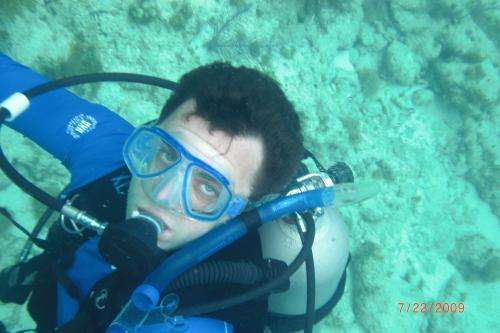Underwater survival story presents physics puzzle

(Phys.org) —When Lawrence Livermore National Laboratory physicist Maxim Umansky flipped through the news, a startling underwater survival story caught his attention. In May, a boat cook survived a 60-hour underwater ordeal 100 feet below the surface after his tugboat sank near the Nigerian coast.
Harrison Okene's survival underwater while the rest of the crew perished was astounding. As described in the media, the man "survived, breathing inside a four-foot high bubble of air as it slowly shrank from the waters rising from the ceiling of the tiny toilet and adjoining bedroom.''
What intrigued Umansky most was the physics behind it. Even though Okene's story is not related to Umansky's physics research in LLNL's Fusion Energy Sciences Program, he wanted to understand the science of this underwater survival, inspired by his interests in physics and scuba diving.
So the LLNL scientist, who joined the Lab in 2001 shortly after obtaining his graduate degree from the Massachusetts Institute of Technology, decided to analyze this physics problem in his spare time after work.
He posed a question that started a discussion of Okene's situation on StackExchange, a website that uses crowdsourcing to answer questions. Myriad users responded to his question, which quickly achieved 30,000 views. Umansky presented a detailed physics analysis of the incident after Rachel Nuwer, a journalist from the online magazine Slate, contacted him.
During the interview, Umansky used his expertise in physics and diving to dissect the situation. Okene was trapped in a capsized boat with an air bubble described as only 4 feet high. Normally, a person would need about 1,000 cubic feet of atmospheric air to survive 60 hours. At a depth of 100 feet, this volume would be compressed by a factor of about 4 by the water pressure, so theoretically an air pocket with dimensions 6x6x6 feet would contain enough oxygen to survive for that time.
It's not the lack of oxygen but poisoning by the exhaled carbon dioxide that would first kill the person in this situation. However, the physics of interaction of atmospheric gases with water could make a critical difference in this case. Carbon dioxide is very soluble in water (much more so than nitrogen and oxygen), and its absorption by the water could have been the reason why carbon dioxide did not build up to the lethal concentration of about 5 percent.
"This man was lucky to survive mainly because a sufficiently large amount of trapped air was in his air pocket," Umansky said. "He was not poisoned by the CO2 after 60 hours spent there, because it stayed at safe levels, and we can speculate that it was helped by the ocean water sealing his enclosure."
By the time divers found and rescued Okene, they were only looking for bodies.
For Okene, it was a harrowing experience and a second chance at life. Umansky, who is well aware of the dangers of being underwater after dozens of dives, is glad that the man survived. And he enjoyed using this happily ended story to satisfy his passion for physics.
Provided by Lawrence Livermore National Laboratory



















